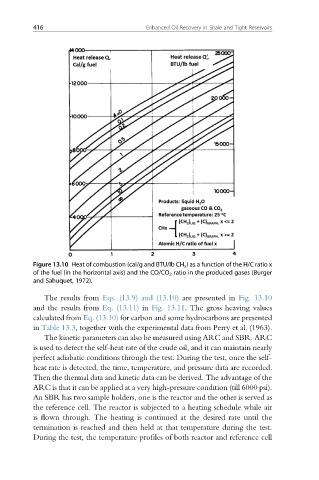Page 449 - Enhanced Oil Recovery in Shale and Tight Reservoirs
P. 449
416 Enhanced Oil Recovery in Shale and Tight Reservoirs
Figure 13.10 Heat of combustion (cal/g and BTU/lb CH x ) as a function of the H/C ratio x
of the fuel (in the horizontal axis) and the CO/CO 2 ratio in the produced gases (Burger
and Sahuquet, 1972).
The results from Eqs. (13.9) and (13.10) are presented in Fig. 13.10
and the results from Eq. (13.11) in Fig. 13.11. The gross heaving values
calculated from Eq. (13.10) for carbon and some hydrocarbons are presented
in Table 13.3, together with the experimental data from Perry et al. (1963).
The kinetic parameters can also be measured using ARC and SBR. ARC
is used to detect the self-heat rate of the crude oil, and it can maintain nearly
perfect adiabatic conditions through the test. During the test, once the self-
heat rate is detected, the time, temperature, and pressure data are recorded.
Then the thermal data and kinetic data can be derived. The advantage of the
ARC is that it can be applied at a very high-pressure condition (till 6000 psi).
An SBR has two sample holders, one is the reactor and the other is served as
the reference cell. The reactor is subjected to a heating schedule while air
is flown through. The heating is continued at the desired rate until the
termination is reached and then held at that temperature during the test.
During the test, the temperature profiles of both reactor and reference cell

